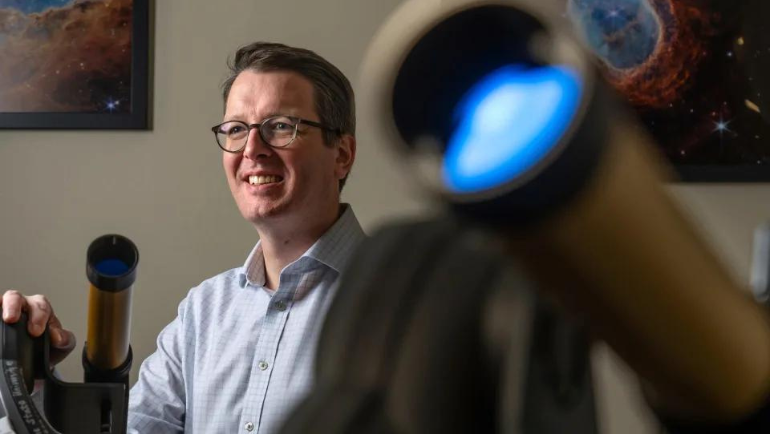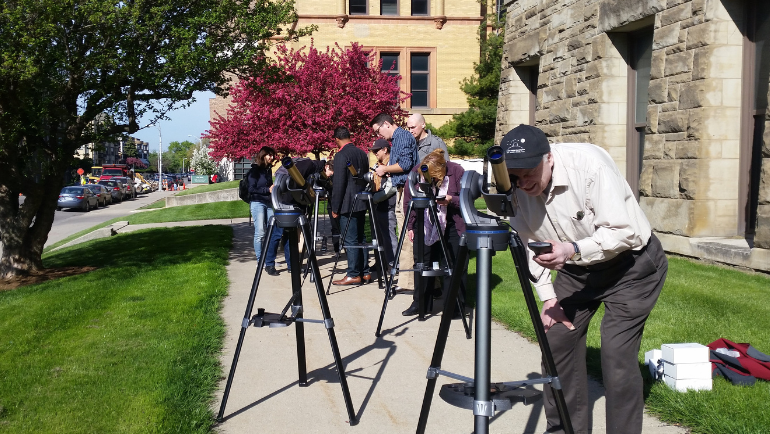WSU astronomer's pro-tips for Detroit's near total solar eclipse on April 8
A near-total solar eclipse will occur in Detroit on Monday, April 8. This is a rare opportunity to experience almost all the light from the sun being blocked out by the moon. Wayne State Department of Physics and Astronomy Chair and Professor Ed Cackett describes how to safely view this extraordinary celestial event and what to expect:

First, and most importantly, you should never look directly at the sun without appropriate eye protection. ⚠️
A solar eclipse occurs when the moon gets between the sun and the Earth. When the moon blocks out some of the light, it is known as a partial solar eclipse. But, when things line up perfectly, the moon can completely block out the sun. This is a rare event known as a total solar eclipse. The last total solar eclipse in the contiguous U.S. was in 2017 and the next one won’t be until 2044. The next total solar eclipse in Michigan will be in 2099! So, make this one count.
Here in Detroit, we are just outside the path of totality of Monday’s eclipse. We will experience a 99.5% eclipse — only a tiny sliver of the sun will remain uncovered. But, this is enough to not get the full effect. If you want to experience the full totality, you will need to drive about an hour south to Toledo, Ohio, or anywhere else along the path. NASA provides a nice map you can explore.
I was lucky enough to experience the total solar eclipse of 2017 from a mountaintop in Idaho. It was spectacular. Several things will happen as totality approaches. The sky darkens, the temperature drops, birds take notice and go quiet, shadows go fuzzy and some will even show the shape of the crescent sun. When it reaches totality, the sun’s atmosphere, which is usually invisible to us, will appear.
First, you see an effect called the "diamond ring" as the last glint from the sun shines like a diamond. Then, the sun’s outer atmosphere, or corona, lights up. You can see the stars in the daytime sky. While totality only lasts a couple of minutes, it is breathtaking. It is well worth the effort to go see it.
You’ll need to keep an eye on the weather. To see the eclipse, we’ll need a clear view of the sun without clouds. At this time of year, there is a 65% chance it will be cloudy. So, everybody keep their fingers crossed that it will be sunny. Even if it is cloudy, you should still notice the sky getting darker.
If you have time, and it looks like the weather will be clear, make the drive to Ohio. But, be wary, thousands of others will be doing the same thing so be prepared for traffic and longer travel times. If you are here in Detroit and can get outside for a few minutes, do so!
The maximum eclipse will be at 3:14 p.m. in Detroit. The partial eclipse starts at 1:58 p.m. and will continue until 4:27 p.m. Timeanddate.com allows you to look up the timings for any location and also shows you what to expect and when.
If you plan to watch the eclipse here are several safe ways to do it. Again, let me repeat, don’t look directly at the sun. Here are the best ways to do it.
Get a pair of eclipse glasses
The Wayne State Planetarium has eclipse glasses available at their shows on Friday, April 5 at 6 p.m. and 7:30 p.m. There is also a film showing at 12:30 p.m. on Wednesday, April 3. The eclipse glasses are available for a minimum $1 (cash only) donation for each pair of glasses (maximum 10 pairs per patron). Please note that planetarium doors are closed during events and our hosts are busy with the show, so glasses are only available immediately before and after the events. If you are looking to get glasses but cannot join for a show, we recommend you visit the Michigan Science Center gift shop which has $2 glasses and is open to the public 10 a.m. to 4 p.m. Tuesday-Sunday. You do not need to pay museum admission to visit the Science Center gift shop.
Make a pinhole camera
Use a sharp point to prick a small hole through a piece of paper or a card. Hold this a few feet away from the ground and it will project an image of the sun. You will need to move it closer or further away from the ground to get the best-projected image.
Use a colander
These already have holes in them! Hold it a few feet from the ground and you should see an image of the eclipse from every hole projected onto the ground.
Use your hands
Overlay your fingers in a criss-cross pattern with small holes between them. Again, hold a few feet away from the ground. Move your fingers closer together or further apart to get the best image. The image will be projected onto the ground.
Look at the shadows around you from trees
As light passes through leaves or cross branches it will make crescent eclipse patterns in the shadows on the ground.

On-campus viewing events
If you're on campus, look out for folks from the Department of Physics and Astronomy. We plan to have solar telescopes for the community to safely view the sun at the following locations:
- The "W" statue located at the intersection of 2nd and Warren Avenues
- In front of Old Main, located at 4841 Cass Ave.
- The fountain on Gullen Mall
Enjoy and send us your photos!